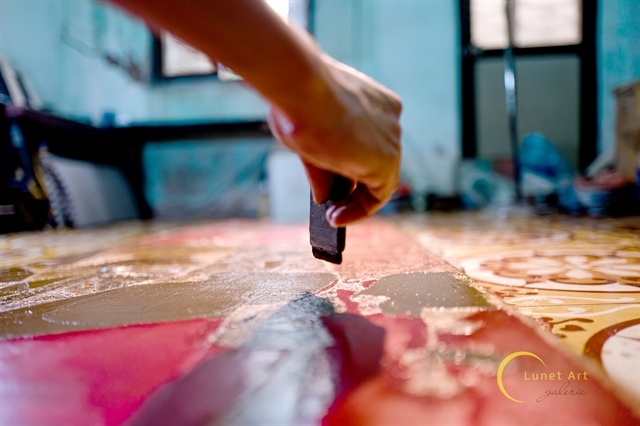 Linh is now creating three new paintings in his studio in Hanoi. Photo: Lunet Art Gallery |
“Traditional lacquer paintings have five basic colours - black, red, yellow, silver, and white,” he explained. “But I rarely use these colours because they limit the effect.”
“Like many other lacquer artists, I have my own colour scheme. These colours used to be unacceptable for lacquer paintings, but if you put them in the right place the results are worth it.”
His works combine traditional materials and modern graphics, and he uses resin from sơn trees (scientifically called Toxicodendron vernicifluum) planted in the northern province of Phu Tho, which is home to a great number of such trees.
Lacquer was originally used to make lacquerware and to decorate wooden items of devotion in temples and pagodas.
It has been used in paintings and fine arts since the 1930s, when artists at the Indochina Fine Arts College began using the traditional handicraft material in their artwork.
Though he knew of lacquer paintings, Linh didn’t have the time required to make even one.
After graduating from the Hanoi University of Fine Arts’ Graphics Department in 1993, he began with paintings on giay do (poonah paper) - another type of traditional Vietnamese artwork.
Poonah paper is made from the bark of poonah trees found in Vietnam’s north. The traditional material has long been used for folk paintings, calligraphy, and documents of dynasties past and family annals.
Linh actually made a living from his poonah paper paintings at that time, all of which depicted the daily life of ethnic minority people and were purchased by collectors. He regrets that he didn’t keep at least one as a souvenir of the first few years of his career.
After success with his poonah paintings, he decided to try his hand at lacquer paintings. Over the course of two years he created 30 or so large works, with help from an assistant.
But he never intended to exhibit them, until one of his classmates held an exhibition. Then he decided to follow suit.
His first solo exhibition was at the Exhibition House in Hanoi in 1999. They were praised by veteran artists such as the late Mai Van Hien and artist/fine arts critic Phan Cam Thuong.
Linh also made a good impression on colleagues and lovers of fine arts because he was already known for his poonah paintings.
That exhibition is one of three he has held in his nearly 30 years as an artist, with the two others being a lacquer exhibition at the Art Vietnam Gallery in Hanoi in 2005 and one in Victoria’s Gallery in Paris in 2014.
He was also part of group exhibitions in Vietnam, China and France, winning third prize at the National Fine Arts Exhibition in 1995.
“Lacquer paintings need a long time to complete,” he said. “The materials must be right. Sometimes I sketch an idea on to paper then develop it into a painting.”
“But that’s not how I make all of my lacquer paintings. It can be difficult to change an idea in lacquer paintings, but sometimes change is a nice surprise.”
“In seeking a different expression from Western paintings, he uses light in a two-dimensional space of images and lines,” explained Luneta Phan, art director at the Lunet Art Gallery.
“With gaps and symbols, a painting’s language can be found in rough works like ancient carvings we often encounter in Buddhism.”
The gallery recently invited him to display at an exhibition entitled Tranh Son Mai - Bieu Hien Và Truu Tuong (Lacquer Painting - Impressionism and Abstractionism) at the Pan Pacific Hotel in Hanoi.
He has at least seven to exhibit, including his latest piece, entitled Danh Gia Vong Toc (Great Clan).
It was created last year and was his first lacquer painting after returning home from France, where he lived from 2000-2016 and where he could not make lacquer paintings.
Danh Gia Vong Toc measures 60cm by 180cm, which is quite different from the regular size of a lacquer painting.
Thoi Gian Trong Tinh Lang (Quiet Time), which he created some time ago, will also be exhibited.
The work includes three pieces, of 33cm by 33cm, and features square and round symbols from yin and yang philosophy. This symbolic description reminds viewers of deep traditional values.
He made it in 2011, but this is the first time it has been displayed in public.
VNS/VNP

















